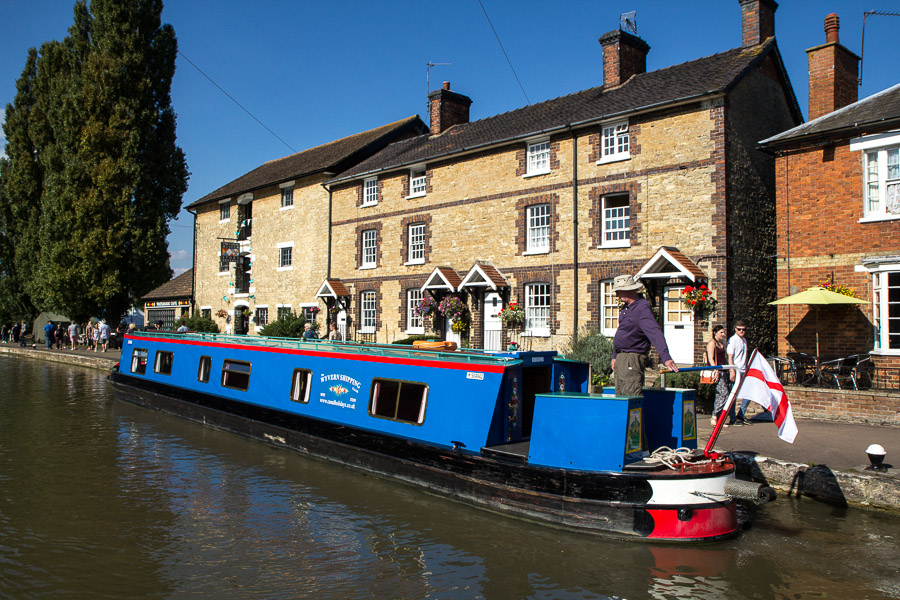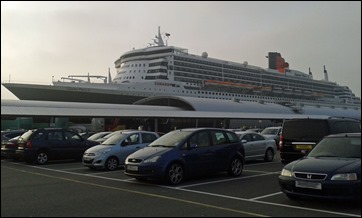 Well, an early start was our plan and an early start we had. Somehow we managed to get our boatload of tourists up and ready by 7:00 AM. Wandering the short distance to our first lock of the day, Francine was inexorably drawn to a field full of cows and early morning mist. Our weather luck was continuing and yet another sunny day was in prospect but we are entering the time of year when misty mornings are common.
Well, an early start was our plan and an early start we had. Somehow we managed to get our boatload of tourists up and ready by 7:00 AM. Wandering the short distance to our first lock of the day, Francine was inexorably drawn to a field full of cows and early morning mist. Our weather luck was continuing and yet another sunny day was in prospect but we are entering the time of year when misty mornings are common.
Photographic urges satisfied, we started off a little after 7:00 AM. Since we thought that the last moving traffic yesterday evening was heading up the locks, we were very surprised and a little upset to find that all five of the locks in the first flight were set against us – empty; Francine and I had to fill them before Capt. Virginia could slip Juniper into them. A flight of locks is where having two lock operators comes in handy: having started one lock, a second operator can go on to the next lock and prepare it before the boat arrives. After four days of practice, by now Francine and I were like a well-oiled machine and we did five locks in under an hour, a truly Olympic performance.
Since we had now used up all the provisions that we brought on board with us, today was always going to have to include a shopping trip. Every day has a water delay, too, and all the water taps we’ve found so far have been slow, taking between 30 and 45 minutes to fill Juniper’s fresh water tank. Added to all this, Banbury is a busy little town jammed with moored boats [no surprise there, then]. With an interesting waterfront anticipated, we decided to increase our time in Banbury even more by trying to find an interesting lunch venue.
Given the sequence of things along the canal, our first stop was our search for lunch. We moored just before the Banbury canal=front itself and sauntered in on foot. What we found was not quite what we expected. The first thing that we noticed was a pleasant enough bridge over the canal, a bridge very colourfully planted with flower baskets. So far so good. The canal-front had clearly been extensively developed with cleanly paved sides. Naturally all moorings here were taken. It was when looking around for the expected plethora of bars, cafes and restaurants that our surprise came. We saw just one cafe, and that with outside tables and chairs largely in the shade of a pedestrian overpass. One bank of the canal was given over to the back of a modern shopping centre, the only thing fronting the canal being the series of service bays for the shops contained therein. On the opposing bank, other than our Hobson’s choice cafe, there seemed to be just a car park and a block of flats. Perfectly pleasant though the flats were, this all felt like a completely wasted opportunity. Barking mad! [Left photo below, courtesy of Ian Rob, right photo below by Paul Gillett.]
The cafe that was present displayed a Greek theme and served Francine and I some very acceptable calamari whilst Capt. and Mrs Virginia chose a burger served with a strangely vivid beetroot mayonnaise [I’m sure it tasted good but it looked odd – this is why I am not a great fan of beetroot]. The waterfront, though, could have been so much more.
Appetite and thirst sated, our next stop was water. We’d hoped Banbury might have decent water pressure. Not so, 35 minutes. A passing narrow boat professional informed me that this was a slow tap. No kidding, aren’t they all?
Eventually we cut loose from the slow tap and went on to our third stop for food and booze. A few bridges further on we’d been told there was a Morrison’s supermarket within spitting distance of some mooring and the bridge. We duly moored, carried all our empty wine bottles (‘cos Morrison’s have recycling bins which is more than I can say for the Canal and River Trust) and went shopping for several days of food and replacement bottles of wine. As a special request from Capt. Virginia, we bought a pound of scallops for scallops with red peppers and rice. We successfully returned to Juniper with three more days-worth of food together with 21 more bottles of wine, too. Well done team!
By now the cruising day was almost over so we left Banbury behind us and found a spot of the canal that maximized our distance from the twin noise generators of a railway line and the constant drone of the M40. We were beside a photographically attractive lift bridge which Francine had her eye on.
In a whole day, we’d managed a staggering 12 miles. Darwin this mode of transport is slow!

























Recent Comments